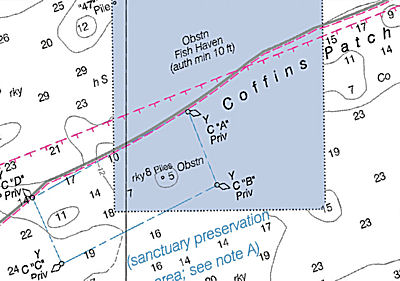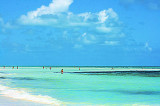
Coffins Patch est assez près du rivage, il a les caractéristiques d'un système récifal côtier. Le récif comprend des piliers rares de coraux et d'autres espèces de corail unique aux touches. Le Sanctuaire zone de préservation (SPA) est d'environ 4 NM (7km) au sud de la colonie Key Beach.
Le SPA est rectangulaire et couvre une superficie d'environ 0.4nm2, soit environ 147ha. Il comprend le récifal entier et une partie des gravats sur le terrain derrière le récif principal. Autres récifs côtiers et hauturiers dans les environs restent ouverts.
La région est facilement accessible, mais il n'y pas de bouées d'amarrage actuellement en place. Il s'agit d'une zone à faible utilisation visité par les plongeurs, les pêcheurs récréatifs, les chasseurs de trésors, et les collectionneurs de souvenirs. On pêche certains poissons tropicaux dans et autour du récif. Le cas échéant, le déplacement des utilisateurs se fera depuis d'autres récifs de la région qui sont ouverts à l'utilisation.
L'enjeu est un récif ovale d'environ 120 m par 22,5 m, c'est le plus connu et le plus fréquenté du groupe Coffins Patch. Il a obtenu son nom d'un grand morceau de tuyau de fer qui s'avance de plusieurs mètres hors de l'eau à un angle du récif. Le tuyau est en fait un des nombreux vestiges d'un phare qui a marqué le récif. Pendant l'ouragan meurtrier de 1935, le phare a été détruit. Ce fut le même ouragan qui s'est terminé au de chemin de fer Henry Flagler. Le récif lui-même a des profondeurs qui varient de 2,1 à 7,5 m. Il est très populaire pour les plongeurs qui apprécient les récifs peu profonds, et il est relativement facile à localiser.










